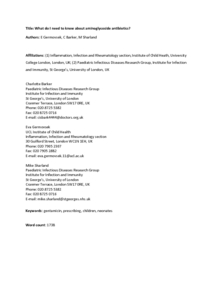Germovsek, E; Barker, CI; Sharland, M
(2017)
What do I need to know about aminoglycoside antibiotics?
Archives of Disease in Childhood: Education and Practice Edition, 102 (2).
pp. 89-93.
ISSN 1743-0593
https://doi.org/10.1136/archdischild-2015-309069
SGUL Authors: Barker, Charlotte Ida Sophia
![[img]](https://openaccess.sgul.ac.uk/108101/1.hassmallThumbnailVersion/ADC-Aminoglycosides-20160411-final-accepted.pdf)  Preview |
|
PDF
Accepted Version
Available under License ["licenses_description_publisher" not defined].
Download (364kB)
| Preview
|
Abstract
The aminoglycosides are broad-spectrum, bactericidal antibiotics that are commonly prescribed for children, primarily for infections caused by Gram-negative pathogens. The aminoglycosides include gentamicin, amikacin, tobramycin, neomycin, and streptomycin. Gentamicin is the most commonly used antibiotic in UK neonatal units. Aminoglycosides are polar drugs, with poor gastrointestinal absorption, so intravenous or intramuscular administration is needed. They are excreted renally. Aminoglycosides are concentration-dependent antibiotics, meaning that the ratio of the peak concentration to the minimum inhibitory concentration of the pathogen is the pharmacokinetic-pharmacodynamic index best linked to their antimicrobial activity and clinical efficacy. However, due to their narrow therapeutic index, the patient’s renal function should be monitored to avoid toxicity, and therapeutic drug monitoring is often required. Here we provide a review of aminoglycosides, with a particular focus on gentamicin, considering their pharmacokinetics and pharmacodynamics, and also practical issues associated with prescribing these drugs in a paediatric clinical setting.
Statistics
Item downloaded times since 01 Aug 2016.
Actions (login required)
 |
Edit Item |


